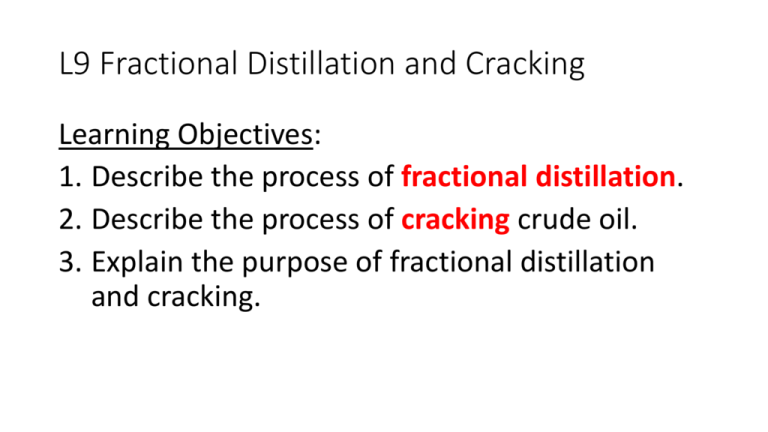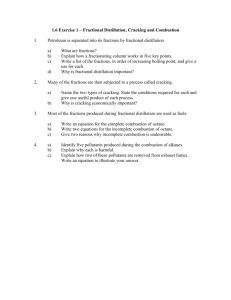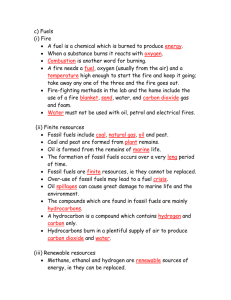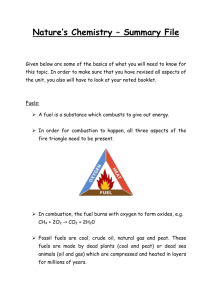L9 Fractional Distillation and Cracking
advertisement

L9 Fractional Distillation and Cracking Learning Objectives: 1. Describe the process of fractional distillation. 2. Describe the process of cracking crude oil. 3. Explain the purpose of fractional distillation and cracking. Write down as many ideas as you can remember about crude oil. ? ? Crude Oil ? ? Crude Oil • Is a mixture of hydrocarbons (made of hydrogen and carbon only). • Hydrocarbons are different lengths, different number of carbons in the chain. • Some hydrocarbons can be used as fuels. • Can be separated based on boiling point. Hydrocarbons – Alkanes (single bonded) No. of Carbons 1 2 3 4 5 n Name x Formula Structure x Hydrocarbons – Alkanes (single bonded) No. of Carbons 1 2 3 4 5 n Name Formula Structure Methane Ethane Propane Butane Pentane x CH4 C2H6 C3H8 C4H10 C5H12 CnH2n+2 x Fuels What are the properties of a good fuel? What type of hydrocarbons are good fuels? Fuels • What are the properties of a good fuel? Highly flammable Releases a lot of energy Complete combustion Easy to transport • What type of hydrocarbons are good fuels? Shorter length hydrocarbons Fractional Distillation 1. 2. 3. 4. 5. 6. 7. 8. Label the diagram Crude Oil (mixture) Fractionating Column Furnace Coldest location Hottest location Shortest hydrocarbons Longest hydrocarbons Fractions Fractional distillation (step by step) • Choose the difficulty for this task. • Write out the step by step method from memory. • Write out the step by step method using a word bank. • Fill in the blanks of a step by step method from memory. • Fill in the blanks of a step by step method using a word bank. • Put a step by step method in the correct order. Fractional Distillation 1. 2. 3. 4. 5. 6. 7. Crude oil, a mixture of hydrocarbons, enters the furnace. All the hydrocarbons are vaporised. The hot gas mixture is pumped into the fractionating column. The hot gases rise up the column. It is hottest at the bottom and coldest at the top. Each hydrocarbon has a different boiling point. Once rises so much that it is colder than the boiling point, the fraction condenses back into liquid and pumped out of the column. 8. The rest of the mixture continues to rise until each fraction has condensed and been removed at a different place up the column. Why is fractional distillation important? Crude oil is a mixture of hydrocarbons. It CANNOT be used as a mixture. Each fraction has different properties and different uses. Useful fuels are the lighter fractions (top of the column). Heavy fractions (bottom) are less useful (Gas Stoves) (Bunsen burners) Which fractions are in the highest demand? Analyse the data, what conclusions can you make? Fractional Distillation alone CANNOT meet the demand for fuels FRACTIONS LPG 1% Naptha 20% Residue 49% Kerosine 10% Inter Gas Oil 10% Light Gas Oil 10% Cracking • Cracking is a process where we break long chain alkanes into shorter chain alkanes and a second product, an alkene. Count up the carbons and hydrogens before and after. They should always be equal. Practice Exam Question • Complete the reaction for the cracking of decane. Alkanes vs Alkenes • Alkanes are hydrocarbons that contain only single bonds. ETHANE BUTANE • Alkenes are hydrocarbons that contain a double bond. ETHENE BUTENE Hydrocarbons – Alkenes (double bonded) No. of Carbons 1 2 3 4 5 n Name Formula Structure x x x x x Hydrocarbons – Alkenes (double bonded) No. of Carbons 1 2 3 4 5 n Name Formula Structure x ethene propene butene pentene x x C2H4 C3H6 C4H8 C5H10 CnH2n x x 2. The gas passes over the catalyst (speeds up reaction). 3. Hydrocarbon “cracks” into short alkane and alkene Cracking in the lab 4. Products flow through tube into test tube 1. Apply heat to long alkane and turns to gas 5. Alkene gas can be tested Test for Alkenes • To test to see if a sample actually contains alkenes we add bromine water. • Bromine water is usually orange. • If the bromine water goes from orange to , the sample has alkenes in it. Why is cracking important? • Cracking allows us to turn useless heavy fractions into useful fuels. • If we did not crack long chain hydrocarbons, we would not be able to meet the demand for fuels such as petrol.







